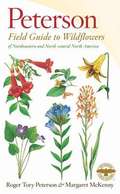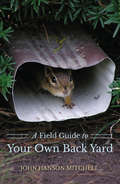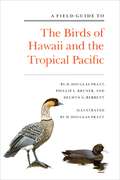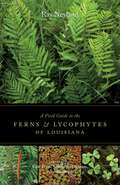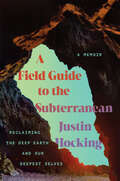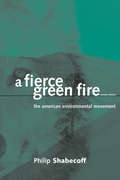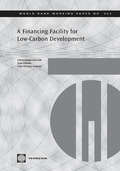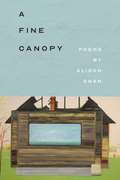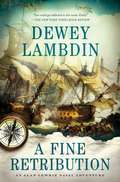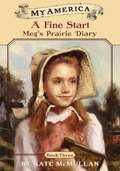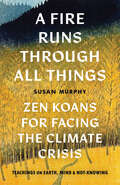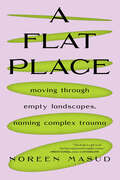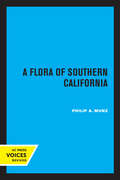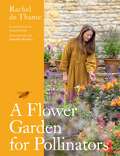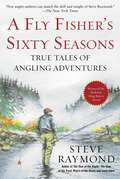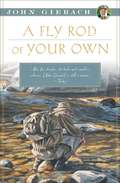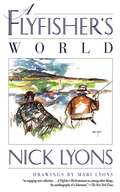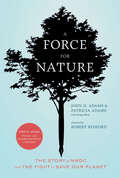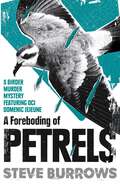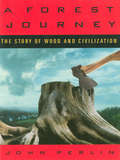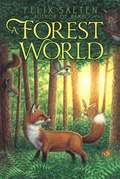- Table View
- List View
A Field Guide to Wildflowers: Northeastern and North-Central North America
by Roger Tory Peterson Margaret MckennyFind what you're looking for with Peterson Field Guides--their field-tested visual identification system is designed to help you differentiate thousands of unique species accurately every time. Grouped by color and by plant characteristics, 1,293 species in 84 families are described and illustrated. Included here are all the flowers you're most likely to encounter in the eastern and north-central U. S. , westward to the Dakotas and southward to North Carolina and Arkansas, as well as the adjacent parts of Canada.
A Field Guide to Your Own Back Yard (Second Edition)
by John Hanson MitchellHere is a book to enhance our appreciation of the small citizens of the world and to introduce us to the neighbors we never knew we had, from spotted salamanders to meadow voles, from snowy tree crickets to ambrosia beetles, all living within steps of your door. "If there is grass and a few scraggling trees, there will be wildlife," suggests John Hanson Mitchell, an internationally recognized naturalist and advocate for tuning your senses to the wonders of your environment. Whether your yard consists of a small stretch of grass or a rambling mix of forest and field, Mitchell will introduce you to the wealth of plants, insects, and animals that share your corner of the world. Learn how the behavior at the birdfeeder mirrors that of the wild woods; get an inside view of the rich ecology of the woodpile; learn why you might want to welcome a skunk into your garden. In short, you'll get to know the neighbors you never knew you had who make their homes all around yours. With wisdom and humor, this book reacquaints you with the denizens of your own local habitat.
A Field Guide to the Birds of Hawaii and the Tropical Pacific
by H. Douglas Pratt Phillip L. Bruner Delwyn G. BerrettThis is the first field guide to the identification of the birds of the islands of the tropical Pacific, including the Hawaiian Islands, Fiji, Samoa, Tonga, southeastern Polynesia, and Micronesia. It is intended both as a reference for the expert and as an introduction to birding in the region for the novice. Small enough to be carried afield, it contains much previously unpublished information about behavior, vocalizations, ecology, and distribution. The forty-five color plates depict all plumages of all bird species that breed in the islands, as well as of those that regularly visit them and the surrounding oceans, and of most species believed to be extinct on the islands. Black-and-white figures show many of the rarer visitors.Introductory sections discuss the tropical Pacific as an environment for birds, problems of birding on islands, and bird conservation. Appendixes include maps of the island groups and a thorough bibliography.
A Field Guide to the Ferns and Lycophytes of Louisiana: An American Soldier in Occupied Germany, 1945--1946
by Ray NeylandAny appreciation of Louisiana's beautiful outdoors must include the lush variety of the state's ferns and lycophytes. Their striking diversity in form, color, and size makes identifying the array of species in the region enjoyable for hobbyists and professionals alike.With illustrations and full-color photographs accompanying a complete description of more than sixty varieties, Ray Neyland's A Field Guide to the Ferns and Lycophytes of Louisiana offers an engaging reference for all levels of interest and expertise. Detailed line drawings of plant structures, a glossary of terms, and dichotomous keys make discovering Louisiana's diverse fern family -- the second largest in the country -- both easy and enjoyable.In addition to providing the geographic range, similar species, and traditional and current uses, Neyland's guide follows the spread of ferns and lycophytes into areas of eastern Texas, southern Arkansas, and Mississippi.
A Field Guide to the Larger Mammals of Tanzania (WILDGuides)
by Charles Foley Lara Foley Alex Lobora Daniela De LucaHome to the Serengeti National Park, Ngorongoro Crater, and Mount Kilimanjaro, Tanzania offers some of the finest big game watching in the world, from elephants and rhinos to chimpanzees and lions. This field guide covers all the larger mammals of Tanzania, including marine mammals and some newly discovered species. Detailed accounts are provided for more than 135 species, along with color photos, color illustrations of marine mammals, and distribution maps. Accounts for land species give information on identification, subspecies, similar species, ecology, behavior, distribution, conservation status, and where best to see each species. The guide also features plates with side-by-side photographic comparisons of species that are easily confused, as well as first-time-ever species checklists for every national park.The definitive, most up-to-date field guide to the larger mammals of Tanzania, including marine mammalsFeatures detailed species accounts and numerous color photos throughoutProvides tips on where to see each speciesIncludes species checklists for every national park
A Field Guide to the Subterranean: Reclaiming the Deep Earth and our Deepest Selves
by Justin HockingA radically inventive excavation of one man&’s life and our relationship to the earth by the critically acclaimed author of The Great Floodgates of the Wonderworld Justin Hocking grew up in a part of Colorado where so many things happened beneath the surface—mining exploits, underground nuclear testing just thirty miles from his family&’s home, and geothermal activity that heats one of the world&’s largest hot spring pools. His homelife, too, was plagued by hidden patterns of abuse and virulent masculinity. A Field Guide to the Subterranean charts the author&’s lifelong process of unearthing the past and reclaiming his own identity and connection to the natural world.How might we transform our traumas into deeper care for one another and the landscapes that sustain us? How do we transcend the mythos of the rugged American male so rooted in extraction and exploitation? And how far can we move beyond the self in a memoir? Hocking explores these and other vital questions by combining personal introspection with expansive narratives that examine geology, ecology, gender theory, mining history, labor rights, and even skateboarding. Abundant with historical research and teeming with birdlife—and ranging in location from remote caves and mountains to secluded surf breaks in Costa Rica—A Field Guide to the Subterranean heralds a boldly original and kaleidoscopic approach to the genres of memoir and nature writing.
A Fierce Green Fire: The American Environmental Movement
by Philip ShabecoffIn A Fierce Green Fire, renowned environmental journalist Philip Shabecoff presents the definitive history of American environmentalism from the earliest days of the republic to the present. He offers a sweeping overview of the contemporary environmental movement and the political, economic, social, and ethical forces that have shaped it. More importantly, he considers what today's environmental movement needs to do to fight off powerful oppositional forces and succeed in its mission of protecting the American people, their habitat, and their future.Shabecoff traces the ecological transformation of North America as a result of the mass migration of Europeans to the New World, showing how the environmental impulse slowly formed among a growing number of Americans until, by the last third of the 20th Century, environmentalism emerged as a major social and cultural movement. He examines the efforts of key environmental figures -- among them Henry David Thoreau, Theodore Roosevelt, Aldo Leopold, and Rachel Carson -- as well as the activities of non-governmental environmental groups, government agencies such as the EPA and Interior Department, and grassroots efforts by communities across America.Originally published in 1993, this new edition brings the story up to date with an analysis of how the of George W. Bush administration sought to dismantle a half-century of progress in protecting the land and its people, and a consideration of the growing international effort to protect Earth's life-support systems and the obstacles the United States government is placing before that effort.Now, when environmental law, institutions, and values are under increased attack and opponents of environmentalism are enjoying overwhelming political and economic power A Fierce Green Fire is a vital reminder of how far we have come in protecting our environment and how much we have to lose.
A Financing Facility for Low-Carbon Development in Developing Countries
by Philippe Ambrosi Ivan ZelenkoThis paper proposes an innovative financing mechanism, known as the Low Carbon Development Facility (LCDF) that would bring additional investment financing at concessional rates to unlock low carbon development projects in non-Annex 1 countries, increasing project-based emissions avoidance in these countries. The LCDF could be a modality of the Copenhagen Green Climate Fund to implement the financial pledges made by Annex 1 countries as a result of Copenhagen and post-COP15 negotiations to support projects, programs, policies and/or other activities in developing countries related to NAMAs. LCDF will not substitute the Global Environment Facility (GEF) and the Clean Technology Fund (CTF) and would rather support the innovative projects pioneered by these instruments.
A Fine Canopy (Made in Michigan Writers Series)
by Alison SwanAlison Swan’s collection of poems, A Fine Canopy, illustrates how the natural world envelops and encloses us with so many beautiful things: crowns of leaves, the ubiquitous blue sky, our luminous moon, and snow. So much snow. An ecopoet whose writing shows her advocacy for natural resources, in this collection Swan calls the reader to witness, appreciate, and sustain this world before it becomes too late. These poems were written out of an impulse to track down wisdom in the open air, outside of the noisy world of cars and commerce. Swan seeks insight on shores and in scraps of woods and fields—especially on four particular peninsulas: Michigan’s upper and lower, Florida, and Washington state’s Olympic—and also inside motherhood, which might be the wildest place of all. These are poems about the interconnection of all things, and "knowing things we cannot see." A journey through seasons with a soundtrack of birdsong, Swan’s words are incredibly sensory. The reader is made to feel the weight of muddy jeans, the jolt at the tug of a dog’s leash, and to see the bright flash of a cardinal’s red plumage. Swan’s poems remind us that although we all want to make a mark on our world, the smaller the better: stepping into fresh snow, dashing through forests atop dry leaves, laying wet bodies on warm concrete. These quiet interactions with places are as hopeful as they are harmless. Without necessarily tackling the topics head-on, A Fine Canopy evokes the devastation of climate change and the destruction of natural resources. This book engages deeply with the other-than-human to express and investigate alarm, dismay, anger, admiration, adoration in what feels like the end of the world unless we begin to think outside the box. These poems will carry weight with all readers of poetry, especially those who are interested in ecopoetry and connecting with the world around them.
A Fine Retribution: An Alan Lewrie Naval Adventure
by Dewey LambdinDewey Lambdin, the reigning master of maritime fiction, continues the adventures of Alan Lewrie, Royal Navy, from his days as a midshipman to captain of his own ship and, though on somewhat dubious grounds, a baronetcy in the 23rd book in the Alan Lewrie series, A Fine Retribution.Captain Alan Lewrie and his small squadron defeat four French frigates off northern Spain, winning honor, glory, and renown. So, why is such a successful captain suddenly without a ship, or another active commission? Why do rumors swirl that jealous foes’ powerful patrons are blighting his career?Months on end ashore, even in entertaining London setting up a household for himself and his retinue, getting his portrait painted, put him in serious sulks. Well, the artist is the sister of one of his midshipmen, a delightful and talented young lady of a modern outlook, but not modern enough to become Lewrie’s lover. Dare he risk a second marriage? Then, just when things are the rosiest, at last, Admiralty calls upon him to develop and command a plan to raid French-held coasts, not with sailors and Marines from his own ship, but with a battalion of Army troops carried in a squadron of transports. It’s intriguing, novel, and a way back to sea, but…can he part from the desirable Jessica Chenery? And if Lewrie does, will his foes allow him to succeed? Be certain that Alan Lewrie will prevail, scruples be damned!
A Fine Start: Meg's Prairie Diary, Book 3 (My America)
by Kate McmullanNine-year-old Meg has finally been reunited with her family in Kansas Territory and life finally seems to be settling down after the pro-slavery ruffians finally were forced to leave. Her third diary is another triumph.
A Fire Runs through All Things: Zen Koans for Facing the Climate Crisis
by Susan MurphyAt a time of climate emergency, Zen koans show us how crisis itself can reveal the regenerative openness of life, mind, and being.Zen koans are a tradition of holistic inquiry based on &“encounter stories&” from East Asia&’s most radical Buddhist tradition. Turning this form of inquiry toward the climate crisis, Susan Murphy contends that koans can help us enter the mind of not-knowing, from which acceptance and possibility freely emerge. Koans reveal intimate, mythic, artful, playful, provocative, humorous, and fierce ways to engage the work of protecting and healing our world.The koans point firstly at ourselves—at the very nature of "self." Until we hold &“self&” as a live question rather than its own unquestioned answer, we&’re stuck looking on from the &“outside,&” hoping to engineer change upon a problem called &“climate crisis,&” all the time oblivious to the fact that we&’re swimming in a reality with no outside to it, an ocean of transformative energy. Do we dare relinquish our wish for absolute control and fearlessly surf the intensity of our feelings about the suffering earth?In addition to her use of dozens of traditional and new koans, Murphy illuminates the little-known Zen resonance with the oldest continuous body of indigenous wisdom on earth, summed up in the subtle Australian Aboriginal word Country. Murphy draws from her study and coteaching with Uncle Max (Dulumunmun) Harrison, a distinguished Yuin Elder, to show how this millennia-deep taproot of intelligence confirms the aliveness of the earth and the kinship of all beings.
A Flat Place: Moving Through Empty Landscapes, Naming Complex Trauma
by Noreen Masud&“...arresting and memorable….Masud both finds a way to comprehend her own story and establishes a strong voice that confirms her as a significant chronicler of personal and national experience.&” – Financial Times "Sharply, subtly, and very movingly, Masud thinks with places, seeking as she does to find a way back into, and then out of, the traumas of her early life." - Robert Macfarlane, author of Underland: A Deep Time Journey A surprising and lyrical journey—part memoir, part nature book—meditating on the meaning of "flatness" and its literary tradition to find ways to understand ourselves and our trauma in one of nature&’s most undervalued wonders. For readers of Robert Macfarlane, G. Sebald's Rings of Saturn, Amy Liptrot's The Outrun, and Richard Mabey's Nature CureDoes the concept of "flat" have an undeservedly bad rap? There are centuries&’ worth of adoration for rolling hills and dramatic, mountainous landscapes. In contrast, flat landscapes are forgettable and seemingly unworthy of poetic or artistic attention. Noreen Masud suffers from complex post-traumatic stress disorder: the product of a profoundly disrupted and unstable childhood. It flattens her emotions, blanks out parts of her memory, and colours her world with anxiety. Undertaking a pilgrimage around Britain's flatlands, seeking solace and belonging, she weaves her impressions of the natural world with poetry, folklore and history, and with recollections of her own early life.Masud's British-Pakistani heritage makes her a partial outsider in these landscapes: both coloniser and colonised, inheritor and dispossessed. Here violence lies beneath the fantasy of pastoral innocence, and histories of harm are interwoven with nature's power to heal. Here, as in her own family history, are many stories that resist the telling. She pursues these paradoxes fearlessly across the flat, haunted spaces she loves, offering a startlingly strange, vivid and intimate account of the land beneath her feet.Masud combines memoir, nature writing, and literary reflection to explore what can be drawn from these powerful places, and to understand her own experience of complex trauma and post-traumatic stress, as well as grief and loss. A Flat Place is a book that drives to the heart of what it means to experience place — bodily and psychologically — and the healing properties of literature and landscape.
A Flight of Butterflies
by Kanzaka SekkaExquisite full-color plates depict 216 winged beauties, soaring and drifting across the pages in apparently seamless flight. Also includes a bonus CD-ROM that features all of the royalty-free butterfly graphics, both in full "flights" and separated into individual units. Ideal for lovers of fine art and for use by graphic artists, designers, and craftworkers.
A Floating School (Fountas & Pinnell Classroom, Guided Reading)
by Kim HankenNIMAC-sourced textbook. A School on Water. Every year, millions of children can't go to school in Bangladesh because of storms and floods. One man had an idea to solve this problem. He used the water to bring the school to the children.
A Flora of Southern California
by Philip A. MunzThis title is part of UC Press's Voices Revived program, which commemorates University of California Press’s mission to seek out and cultivate the brightest minds and give them voice, reach, and impact. Drawing on a backlist dating to 1893, Voices Revived makes high-quality, peer-reviewed scholarship accessible once again using print-on-demand technology. This title was originally published in 1974.
A Flower Garden for Pollinators: Learn how to sustain and support nature with this practical planting guide
by Rachel de ThameThe perfect guide for any gardener looking for inspiration on how to create a pollinator-friendly garden all year round.Pollinators are essential to life on Earth. Yet bees, butterflies and other beneficial insects are struggling due to climate change and habit loss. Fortunately, what we choose to plant in our gardens can help them to thrive. In this heartfelt guide, horticulturalist and Gardener's World presenter Rachel de Thame highlights plants we can grow that are rich in nectar and pollen, ensuring the garden is filled with beautiful flowers for us all to enjoy year-round.Arranged by season and illustrated with exquisite hand-painted watercolours and glorious photography showcasing many of Rachel's favourite plants, this book provides a captivating look at how best to support nature. Whether you have a small urban courtyard or a large country garden, A Flower Garden for Pollinators will guide your choice of plants, attracting a host of pollinators to your own patch of paradise.'A wonderful journey through the magical world of plants.' - Frances Tophill
A Flower Garden for Pollinators: Learn how to sustain and support nature with this practical planting guide
by Rachel de ThameThe perfect guide for any gardener looking for inspiration on how to create a pollinator-friendly garden all year round.Pollinators are essential to life on Earth. Yet bees, butterflies and other beneficial insects are struggling due to climate change and habit loss. Fortunately, what we choose to plant in our gardens can help them to thrive. In this heartfelt guide, horticulturalist and Gardener's World presenter Rachel de Thame highlights plants we can grow that are rich in nectar and pollen, ensuring the garden is filled with beautiful flowers for us all to enjoy year-round.Arranged by season and illustrated with exquisite hand-painted watercolours and glorious photography showcasing many of Rachel's favourite plants, this book provides a captivating look at how best to support nature. Whether you have a small urban courtyard or a large country garden, A Flower Garden for Pollinators will guide your choice of plants, attracting a host of pollinators to your own patch of paradise.'A wonderful journey through the magical world of plants.' - Frances Tophill
A Fly Fisher's Sixty Seasons: True Tales of Angling Adventures
by Steve RaymondWitty and heartfelt, Sixty Seasons looks back over more than half a century of fly fishing and writing about fly fishing. Steve Raymond returns with an informative and delightful collection of memories, stretching over his sixty seasons spent fishing. Raymond takes the opportunity to write passionately about the full cast of his life, as well as how fly-fishing interacts with his life as a journalist, and vice versa. He offers sage advice about books, writers, rods, methods, and guides. He deftly ranges from joyful topics to bittersweet moments to a tongue-in-cheek quiz designed to test your fly-fishing sophistication. Other contemplations include:Essays on fishing for trout, steelhead, bonefish, and carp Surviving a career in journalism Fishing for Atlantic salmon vs. Pacific salmon The impending future of outdoor sports It is with good humor, precision, and thoughtful insight that Raymond reels you in. Sixty Seasons is a must-have for anyone who loves fly-fishing or the natural world.
A Fly Rod of Your Own (John Gierach's Fly-fishing Library)
by John GierachJohn Gierach, “the voice of the common angler” (The Wall Street Journal) and member of the Fly Fishing Hall of Fame, brings his sharp sense of humor and keen eye for observation to the fishing life and, for that matter, life in general.John Gierach is known for his witty, trenchant observations about fly-fishing. In A Fly Rod of Your Own, Gierach once again takes us into his world and scrutinizes the art of fly-fishing. He travels to remote fishing locations where the airport is not much bigger than a garage and a flight might be held up because a passenger is running late. He sings the praises of the skilled pilots who fly to remote fishing lodges in tricky locations and bad weather. He explains why even the most veteran fisherman seems to muff his cast whenever he’s being filmed or photographed. He describes the all-but-impassable roads that fishermen always seem to encounter at the best fishing spots and why fishermen discuss four-wheel drive vehicles almost as passionately and frequently as they discuss fly rods and flies. And while he’s on that subject, he explains why even the most conscientious fisherman always seems to accumulate more rods and flies than he could ever need. As Gierach says, “fly-fishing is a continuous process that you learn to love for its own sake. Those who fish already get it, and those who don’t couldn’t care less, so don’t waste your breath on someone who doesn’t fish.” From Alaska to the Rockies and across the continent to Maine and the Canadian Maritimes, A Fly Rod of Your Own is an ode to those who fish—and they will get it.
A Flyfisher's World
by Nick Lyons Mari LyonsThis ample selection of articles and essays by one of America's most popular writers about fly-fishing begins with a moment on Michigan's Au Sable River--the exact moment when the author lost his heart to fly-fishing. This collection chronicles a fishing life punctuated by a revealing trip with one of his grown sons and mellow reflections from a hospital bed.This is the broadest of Nick Lyons's books, with sections on tarpon and pike fishing in the Marquesas and in France, bass bugging on a small Connecticut pond, and trout fishing on unnamed creeks and blue-ribbon western rivers, as well as reflections on such aspects of the sport as the flies that are the underpinning of it all, the pursuit of records, the odd characters he's met along the way, and the increasing challenge of crowds who pursue this ever-popular sport.By turns canny, hilarious, inquiring, and philosophic, A Flyfisher's World is an impressive addition to Nick Lyons's important body of writing about fly-fishing.
A Force for Nature: The Story of NRDC and the Fight to Save Our Planet
by John H. Adams Patricia Adams Air Vice Marshal George BlackThe pioneering environmental activist recounts his decades-long fight for our planet through the NDRC—with a foreword by Robert Redford.In 1970, John H. Adams was fed up with the levels of pollution in New York City. How could he raise children in a place where layers of soot covered the windows? Working as a lawyer for the U.S. Attorney’s office, he and fellow lawyers teamed up to form Natural Resources Defense Council, a grassroots environmental advocacy group. Over the years, NDRC has grown into an international powerhouse with 1.2 million members and a staff of scientists and lawyers whose mission is to safeguard the planet. This inspiring memoir tells the story of the NRDC and the environmental movement it sparked.
A Foreboding of Petrels: Birder Murder Mysteries (Birder Murder Mysteries)
by Steve BurrowsOn suspension and unable to work, DCI Domenic Jejeune finds his attention snared by an unexplained death at an Antarctic research base. Meanwhile, DS Danny Maik investigates a string of arson attacks in Norfolk. When a corpse is discovered in a bird hide, Danny&’s investigation escalates. It appears the body links the two enquiries, but the men are unable to share information. As they attempt to unravel a twisted web of leads involving Antarctic researchers, uncompromising climate scientists and billionaire philanthropists, Jejeune is forced to decide how much he is willing to sacrifice in the pursuit of truth. Praise for the series &‘One of the most delightful mysteries of recent years.&’ Daily Mail &‘A most entertaining read.&’ The Times
A Forest Journey: The Story of Wood and Civilization
by John PerlinA contemporary view of the effects of wood, as used for building and fuel, and of deforestation on the development of civilization. Until the ascendancy of fossil fuels, wood has been the principal fuel and building material from the dawn of civilization. Its abundance or scarcity greatly shaped, as A Forest Journey ably relates, the culture, demographics, economy, internal and external politics, and technology of successive societies over the millennia. The book's comprehensive coverage of the major role forests have played in human life--told with grace, fluency, imagination, and humor—gained it recognition as a Harvard Classic in Science and World History and as one of Harvard's "One-Hundred Great Books." Others receiving the honor include such luminaries as Stephen Jay Gould and E. O. Wilson. This new paperback edition will add a prologue and an epilogue to reflect the current situation in which forests have become imperative for humanity's survival.
A Forest World
by Felix SaltenThe forest is a whole different world. . . Felix Salten's classic story of wild and tame animals coming together is brought vividly to life in this refreshed edition. To the animals of Lodge Farm, the woods are a forbidden place filled with danger and uncertainty. For the wild animals in the forest, the farm is just as frightening, because Man lives there. The two worlds are next to one another, but couldn't be further apart. When the groups, tame and wild, begin to interact, each begins to question how life would be different on the other side. Manni the donkey ventures into the forest for an adventure, while a doe and her two fawns seek the safety of the barn when poachers threaten them in the woods. Will the animals choose to stay in their new lives? Or will the call of home be too great?
